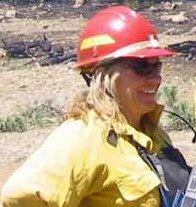The Tehipite fire in Kings Canyon National Park and the Sierra National Forest has been burning since July 14. It can now be observed almost live on a web cam. Here is an example from Tuesday afternoon.

From InciWeb:
Hayman fire trial: burned letter did not start the fire

From TheDenverChannel:
Prescribed fires help control cedar invasion in Nebraska
The Tehipite Fire has grown to 4,337 acres as of Monday afternoon. Of that acreage, 2,353 acres are within Kings Canyon National Park and 1,984 acres are within the Sierra National Forest. The park and the forest are working together to manage the fire.In the last several days, the fire has shown increased activity and growth including within the Scepter and Crown Creek drainages on the Sierra National Forest and northwest of Tehipite Valley and north to Kettle Dome in Kings Canyon National Park.
Hayman fire trial: burned letter did not start the fire

Terry Barton, 2002 file photo
From TheDenverChannel:
DENVER -- The lead U.S. Forest Service investigator into the cause of Colorado's largest wildfire testified Tuesday that she doesn't believe a burning letter sparked the fire.Agent Kimberly Jones was testifying in a Denver federal civil case where five insurance companies and several property owners are suing the federal government for more than $7 million because a USFS employee was convicted of starting the 2002 Hayman wildfire.When Jones testified that she didn't believe there ever was a letter burned by Terry Barton, the judge interrupted the questioning to ask Jones if she had testified to that previously. She told the judge she was never asked that question on the stand before.Jones was then asked if that meant that in her opinion that Barton lied when she stipulated that everything in her plea bargain was fact and Jones replied, "Yes."The plaintiffs are arguing that Barton burned a letter in a campfire ring to make the case that Forest Service is responsible for the 138,000-acre fire that ultimately destroyed 133 homes and outbuildings over three weeks in June 2002.Plaintiffs are arguing there is a letter to make the case and so the Forest Service is responsible.Barton was a Forest Service worker who was charged with enforcing the fire ban when she said she burned a two-page letter in a fire ring near Lake George, Colo., and it spread in the dry tinder, sparking the wildfire. The next day, the fire ran 17 miles due to extremely dry conditions.She did not admit starting the fire until after her arrest. She was convicted and spent nearly six years in a federal prison.
HERE is a link to other articles on Wildfire Today about Terry Barton.
Prescribed fires help control cedar invasion in Nebraska
Left unchecked, cedar trees will invade land in the prairie states and decrease its grazing potential. The state's Natural Resources Conservation Service helps landowners manage this problem. Here is an excerpt from an article in the North Platte Bulletin:
.....The trees are sheared off at the base, and then stacked in large piles. To help keep the trees from becoming a problem again, NRCS designs a grazing management plan and recommends landowners conduct a prescribed burn every three to five years after the initial tree cutting has occurred. A prescribed maintenance burn will be required periodically thereafter to maintain the grassland ecosystem.According to Nichols, fire is one of the most effective methods in controlling cedar trees. But since fire has been removed from the landscape out of fear of causing property damage, the cedar problem has exploded. NRCS, as well as other private organizations like Quail Forever and the Loess Canyons Rangeland Alliance, is working with landowners to help increase the use of prescribed burns.“A prescribed burn is a highly controlled fire. It isn’t anything like a wildfire. It’s only conducted under very specific conditions after a lot of planning. Once a landowner experiences a prescribed burn and understands how controlled it is, the practice becomes much less intimidating,” Nichols said.Historically, prairies evolved with disturbances like grazing from bison and antelope, and from wildfires. These disturbances worked together to help keep the prairie system healthy. The hoof action of the grazing animals trampled dead organic matter into the soil. Their grazing helped stimulate new plant growth, and fire helped control excessive woody vegetation.




No comments:
Post a Comment